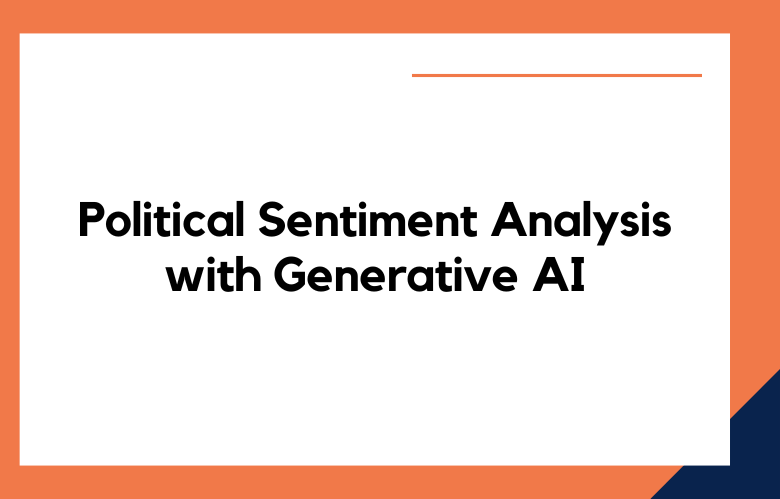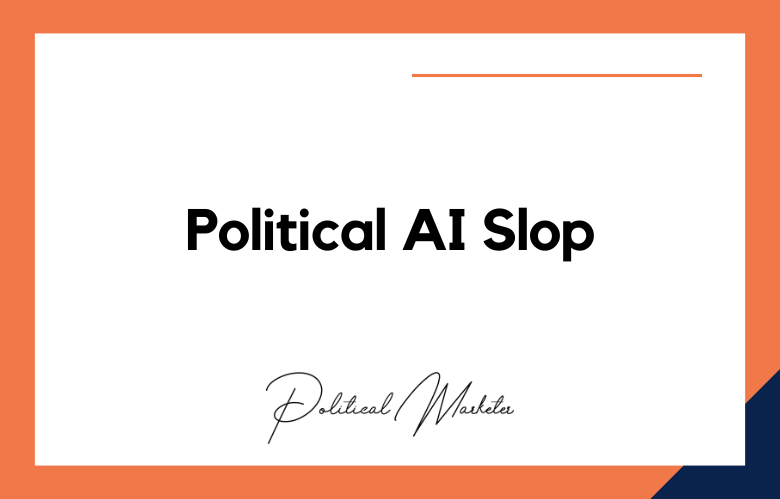Politics is a highly discussed topic that impacts our daily lives more than we realize. With the emergence of social media, online platforms have become a space where opinions on politics are plenty. Analyzing political sentiments has become challenging, especially with the expanse of social media, where data can be overwhelming.
Traditional methods can be insufficient for social media analytics, especially as it is where people tend to express their opinions freely. With the advancement of technology, generative AI has become an excellent solution for political sentiment analysis.
Generative AI is built to learn from patterns and generate output like a human. While its primary use is to produce new images and videos, it is now used for sentiment analysis. With an adequate data pool, generative AI algorithms provide meaningful insights that traditional sentiment analysis could not.
The technology understands context and can quickly analyze vast amounts of data, which can be incredibly helpful when analyzing political sentiments.
Cracking the Code: How Generative AI is Tackling Political Sentiment Analysis
With the unprecedented increase in the use of social media platforms and the Internet, it has become increasingly important to monitor and analyze political sentiments expressed by individuals online. To this end, Generative Artificial Intelligence (AI) is slowly emerging as a powerful tool for tracking and predicting political opinion.
Generative AI uses powerful machine learning algorithms and natural language processing (NLP) capabilities to generate new data based on patterns learned from large datasets. When applied to political sentiment analysis, it can detect and understand complex political language and its tone or emotion.
Political sentiment analysis using Generative AI has been practical in several situations. For instance, it has been used to predict the outcomes of political events such as elections, rallies, and debates. With large amounts of data gathered from social media, traditional news outlets, and public statements, this technology can generate insights about political sentiments even before a real-world event has occurred.
Unleashing the Power of Generative AI in Political Sentiment Analysis
In recent years, social media platforms have facilitated more political discourse and commentary online. This has led to an explosion of data that can be analyzed and leveraged to gain valuable insights into public opinion on political issues and even inform decision-making.
However, sorting through the vast amount of unstructured data can be a monumental task, and traditional sentiment analysis methods often need to be more accurate in capturing the nuances and complexities of political sentiment.
This is where generative AI comes in. This new approach to sentiment analysis leverages neural networks and other advanced machine-learning techniques to understand and interpret the meaning behind individual words and phrases.
By learning from vast training data, these algorithms can accurately identify the underlying sentiment behind a text, even when it contains sarcasm, irony, or other contextual cues.
Bridging the Divide: The Role of Generative AI in Understanding Political Sentiment
Generative AI and Political Sentiment
Generative AI has the potential to bridge the divide between political parties by helping to better understand public sentiment. Using natural language processing (NLP) algorithms, generative AI can analyze vast amounts of data to uncover patterns and trends in public opinion.
This data can then identify areas of agreement or disagreement between different political ideologies, enabling us to better understand the underlying motivations behind certain beliefs and opinions.
Improved Decision Making
The use of generative AI can also help improve government decision-making processes. By analyzing public sentiment, generative AI can provide insights into how people feel about specific policies or initiatives. This allows politicians to make more informed decisions based on what their constituents want, which could lead to more effective policy-making and increased public engagement with government processes.
Increased Transparency
Generative AI can also increase transparency in the political process by providing a more comprehensive view of public opinion. By gathering and analyzing data from multiple sources, generative AI can accurately understand how people feel about specific issues or candidates, allowing for a more informed discussion among stakeholders and greater accountability from elected officials.
Enhanced Public Discourse
Generative AI can also enhance public discourse by providing a platform for people from different backgrounds and ideologies to engage in meaningful conversations about politics and current events.
By creating an environment where diverse perspectives are welcomed and respected, generative AI could foster greater understanding between opposing sides while promoting constructive dialogue around important topics such as healthcare reform or immigration policy.
Improved Representation
Generative AI could also improve political representation by ensuring that all voices are heard equally in the political process. By gathering information from various sources, generative AI can help ensure that minority groups are not overlooked or underrepresented in policy-making decisions or forming legislative initiatives.
This could lead to greater diversity within government and improved outcomes for all citizens regardless of their background or beliefs.
Increased Participation
Generative AI could increase participation in the political process by providing citizens with easier access to information about candidates, policies, and upcoming elections.
By making it easier for people to find out what is going on in their local area or nationally, generative AI could encourage more individuals to get involved with politics at all levels of government—from local school boards up through federal offices—and become active members of their communities civic life.
AI Vs. Political Polarization: Exploring Generative Models for Sentiment Analysis
Introduction to Generative Models
Generative models are artificial intelligence (AI) that can analyze sentiment and classify text. These models use deep learning algorithms to understand the context of a given sentence or document and generate a response accordingly. Generative models are beneficial for sentiment analysis because they can detect subtle nuances in language that would otherwise be difficult to identify.
Benefits of Using Generative Models for Sentiment Analysis
Generative models offer several key benefits when it comes to sentiment analysis. First, they can help reduce the time and effort needed to manually label data sets, as the model will do much of the work for you.
Generative models can detect more nuanced emotions than traditional methods, leading to more accurate results. They can also help reduce political polarization by providing an objective measure of sentiment rather than relying on subjective human judgment.
Challenges with Generative Models
Despite their many advantages, generative models also present some challenges regarding sentiment analysis. One major challenge is that these models require large amounts of data to produce accurate results, which can be expensive and time-consuming. Generative models may not always accurately capture the nuances of human language, which could lead to inaccurate results if not appropriately addressed.
AI-Assisted Political Polarization Detection
To address political polarization, researchers have begun using AI-assisted methods for detecting and analyzing sentiment in text data sets. These methods rely on natural language processing (NLP) techniques such as topic modeling and sentiment analysis to identify patterns in speech that could indicate political bias or polarization within a given population or group of people.
Applications for AI-Assisted Political Polarization Detection
AI-assisted political polarization detection has several potential applications ranging from public opinion polling and market research to media monitoring and election forecasting. By leveraging AI technologies such as machine learning and natural language processing, organizations can gain insights into how people feel about specific topics or issues and use this information for decision-making.
Advantages Over Traditional Methods
AI-assisted methods have several advantages over traditional methods for detecting political polarization. These include increased accuracy due to a better understanding of context, improved scalability due to automated processes, faster turnaround times due to reduced manual labor, and cost savings due to fewer resources required for data collection and analysis processes.
Disadvantages
As with any technology, there are also some disadvantages associated with AI-assisted political polarization detection, including ethical considerations such as privacy concerns, potential bias from algorithms, lack of transparency regarding how decisions are made, potential inaccuracy due to incorrect assumptions about context or meaning, difficulty interpreting complex emotions; and difficulty generalizing findings across different populations or contexts.
From Bots to Better Insights: How Generative AI Revolutionizes Political Sentiment Analysis
Political sentiment analysis has become essential in understanding public opinion and predicting electoral outcomes. Until recently, the most common method of analyzing political rhetoric involved using bots to scrape social media platforms for mentions of political candidates or issues.
However, the limitations of this approach have become increasingly apparent in recent years as social media platforms have strengthened their algorithmic defenses against bots.
The emergence of generative AI technology has revolutionized political sentiment analysis. Rather than simply scraping and analyzing text data, productive AI systems can understand the context and nuances of political discourse, allowing for a more accurate and insightful analysis of public opinion.
The Sentiment Experiment: Harnessing Generative AI for Political Analysis
Political analysis is an essential aspect of modern society, as the decisions made by leaders and politicians directly impact citizens’ lives. Over the years, various methods have been used to analyze political sentiment and public opinion, including polls, surveys, and a focus on generative AI. With the advent of generative AI, a new and exciting approach to political analysis has emerged.
The Sentiment Experiment is one such application of generative AI. It aims to harness the power of deep learning algorithms to analyze political sentiment. The project gathers and analyzes data from various sources, including social media, news articles, blogs, and other online sources, to gain insights into public opinion and political sentiment.
Politics Unplugged: Using Generative AI to Decode Political Sentiment
Politics Unplugged is a revolutionary project that seeks to utilize the power of generative artificial intelligence (AI) to extract valuable insights from political sentiment analysis.
The project aims to decode complex political sentiments and biases by analyzing large data sets from various public platforms such as social media, news articles, and blogs. By doing so, it intends to provide a deeper understanding of political systems and enable organizations and individuals to make more informed decisions.
The use of automated algorithms that can recognize patterns in large amounts of data enables a more in-depth analysis of political sentiments in real time. By harnessing machine learning technology, Politics Unplugged can extract insights into the electorate’s opinions, attitudes, and preferences toward political issues.
This technology can also identify the political leaning of individuals, groups, and institutions, thereby providing valuable data for policymakers, politicians, and businesses to make informed, data-driven decisions.
Conclusion
Generative AI has revolutionized political sentiment analysis. Its ability to analyze vast amounts of social media data facilitates in-depth analysis of societal attitudes and opinions on political issues. It assists political analysts in making informed decisions with invaluable insights. As technology develops, generative AI will continue revolutionizing how we see and analyze political sentiments.
Generative AI is a crucial solution for the challenges related to political sentiment analysis. With its unmatched ability to handle complex data, generative AI can help political strategists understand the electorate’s sentiments and help shape campaign messaging that resonates with the voters.
The future of political sentiment analysis looks bright, with generative AI at the forefront of innovation. Politicians and strategists who embrace this technology will be better equipped to understand and address their constituents’ concerns and opinions.











